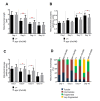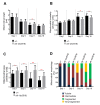Age-dependent changes in mitochondrial morphology and volume are not predictors of lifespan
- PMID: 24642473
- PMCID: PMC3969280
- DOI: 10.18632/aging.100639
Age-dependent changes in mitochondrial morphology and volume are not predictors of lifespan
Abstract
Mitochondrial dysfunction is a hallmark of skeletal muscle degeneration during aging. One mechanism through which mitochondrial dysfunction can be caused is through changes in mitochondrial morphology. To determine the role of mitochondrial morphology changes in age-dependent mitochondrial dysfunction, we studied mitochondrial morphology in body wall muscles of the nematodeC. elegans. We found that in this tissue, animals display a tubular mitochondrial network, which fragments with increasing age. This fragmentation is accompanied by a decrease in mitochondrial volume. Mitochondrial fragmentation and volume loss occur faster under conditions that shorten lifespan and occur slower under conditions that increase lifespan. However, neither mitochondrial morphology nor mitochondrial volume of five- and seven-day old wild-type animals can be used to predict individual lifespan. Our results indicate that while mitochondria in body wall muscles undergo age-dependent fragmentation and a loss in volume, these changes are not the cause of aging but rather a consequence of the aging process.
Conflict of interest statement
The authors of this manuscript have no conflict of interest to declare.
Figures






References
-
- Janssen I, Baumgartner RN, Ross R, Rosenberg IH, Roubenoff R. Skeletal muscle cutpoints associated with elevated physical disability risk in older men and women. Am J Epidemiol. 2004;159:413–421. - PubMed
-
- Visser M, Schaap LA. Consequences of sarcopenia. Clin Geriatr Med. 2011;27:387–399. - PubMed
-
- Bruusgaard JC, Egner IM, Larsen TK, Dupre-Aucouturier S, Desplanches D, Gundersen K. No change in myonuclear number during muscle unloading and reloading. J Appl Physiol. 2012;113:290–296. - PubMed
-
- Carlson BM, Faulkner JA. Muscle transplantation between young and old rats: age of host determines recovery. Am J Physiol. 1989;256:C1262–1266. - PubMed
Publication types
MeSH terms
Grants and funding
LinkOut - more resources
Full Text Sources
Other Literature Sources
Medical
Research Materials

